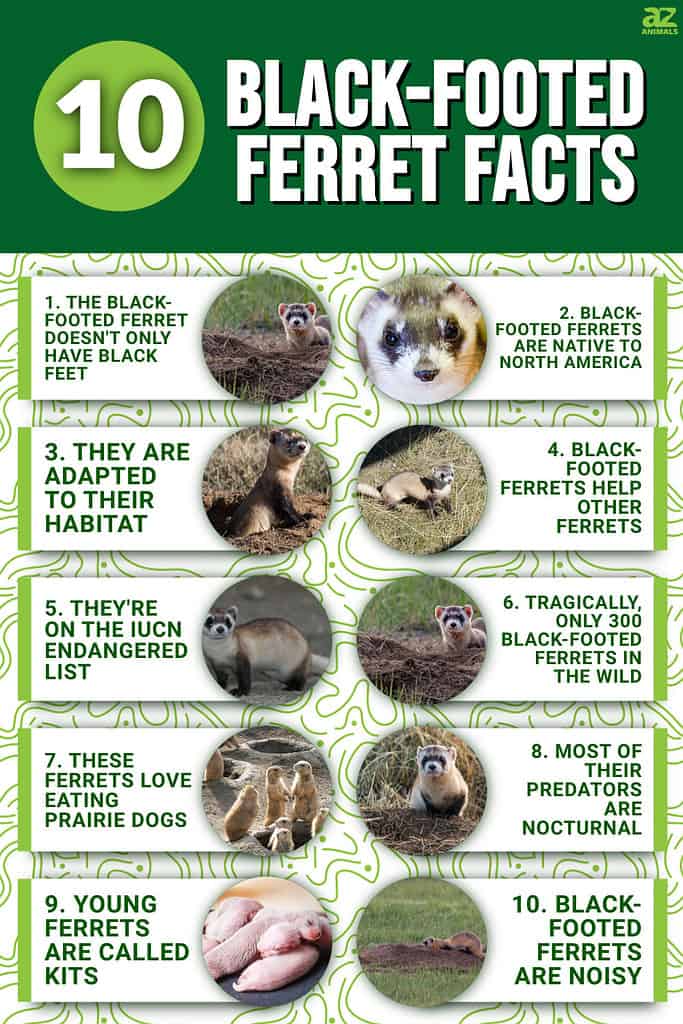Ferrets are fascinating creatures that can fit inside a teaspoon when they are newborns and were once the third most common pets in the U.S. They are known to be notoriously clumsy, but they are hard workers and can be trained.
Ferrets also have a unique ability to sleep like logs and love to dance. Despite being domesticated, there are still ferrets in the wild today. Historically, ferrets were used to hunt rabbits and rodents, as their lean bodies and curious nature make them natural hunters.
Ferrets are fearless and not afraid of anything, which makes them great friends for cats, dogs, and other ferrets. They have highly developed hearing and smell but poor eyesight. Overall, ferrets are social, flexible, and bring a lot of joy to their owners.

Credit: a-z-animals.com
Interesting Ferret Facts
Curious and quirky, ferrets are fascinating creatures with a range of unique characteristics. From their tiny size at birth to their natural aptitude for dancing, here are some interesting ferret facts that will leave you amazed.
Newborn Ferrets Can Fit Inside A Teaspoon
Believe it or not, newborn ferrets are so tiny that they can fit inside a teaspoon! These adorable creatures weigh just a few grams when they’re born, and their petite size is hard to comprehend.
They Were Once The Third Most Common Pet In The U.s.
In the past, ferrets were incredibly popular pets in the United States, ranking as the third most common pet. Their playful and social nature made them a beloved choice for many households.
They’re Notoriously Clumsy
Despite their nimble and agile appearance, ferrets are actually quite clumsy. Their natural curiosity often gets the better of them, leading to amusing tumbles and stumbles as they explore their surroundings. You’ll certainly have a good laugh watching a ferret navigate its way through its environment!
They’re Hard Workers
Did you know that ferrets have been used for work? Historically, these small creatures were employed to hunt rabbits and rodents. Their slender bodies and inquisitive nature made them the perfect choice for entering holes and burrows to flush out their prey. In fact, the phrase “ferret out” originates from this very practice.
They Like To Dance
When a ferret is feeling particularly playful and excited, they often engage in a delightful behavior known as the “war dance.” During this dance, which involves a series of quick hops, jumps, and twists, the ferret displays its sheer joy and enthusiasm. It’s a truly adorable sight!
They Sleep Like Logs
When it comes to sleeping, ferrets take relaxation to a whole new level. These furry creatures are known for their ability to sleep like logs, often snoozing for up to 18 hours a day. You’ll often find them curled up in a cozy corner, completely oblivious to the world around them.
They Can Be Trained
Contrary to popular belief, ferrets can be trained to perform tricks and obey commands. With patience and positive reinforcement, you can teach your furry friend to fetch, roll over, and even use a litter box. Their intelligence and curiosity make them quick learners.
There Are Still Ferrets In The Wild Today
While many ferrets are domesticated pets, there are still wild ferret populations in existence today. Species such as the European polecat, stoat, black-footed ferret, and least weasel continue to thrive in their natural habitats, adding to the diversity of our planet’s wildlife.

Credit: www.redbubble.com
Ferrets As Hunters
Ferrets have a natural hunting instinct, making them skilled hunters of rabbits and rodents. They are agile and curious, allowing them to navigate tight spaces and “ferret out” their prey.
Historical Use Of Ferrets In Hunting
Ferrets have a long history of being used as hunting companions. Dating back to ancient times, these small and agile creatures were highly valued for their incredible ability to chase down prey, particularly rabbits and rodents. They were often employed for their skills in flushing out game from their burrows, thanks to their slender bodies and inquisitive nature.
Their Curiosity And Agility
One of the reasons why ferrets excel as hunting animals is their natural curiosity and agility. Their innate curiosity drives them to explore every nook and cranny, making them adept at ferreting out hidden prey. The ability to squeeze into tight spaces and navigate complex terrain with grace and ease makes them invaluable assets to hunters.
The Origin Of The Expression ‘ferret Out’
The expression “ferret out” has its roots in the historical use of ferrets as hunting animals. It refers to the act of using ferrets to find and drive out game from their hiding places. This term has now become a metaphorical expression, often used to describe the process of uncovering or discovering something through diligent and persistent searching.
Ferret Facts For Owners
Discover fascinating facts about ferrets! Did you know that newborn ferrets can fit inside a teaspoon? They were once the third most common pet in the U. S. and they’re notorious for being clumsy. Find out more interesting facts about these adorable animals!
If you are a proud ferret owner, you may already know that these little critters are full of surprises. From their unique behaviors to their playful nature, ferrets have a lot to offer as pets. In this section, we will explore some interesting facts about ferrets that every owner should know.
Hide And Seek Is Their Favorite Game
Ferrets absolutely love playing hide and seek! They have a natural instinct to hide and sneak around, making it an exciting game for them. As an owner, you can join in the fun by creating hiding spots for your ferret or playing a game of chase with them. Just make sure to provide a safe environment for them to explore and hide in.
Over-bathing Makes Them Smellier
Contrary to popular belief, over-bathing your ferret can actually make them smellier. Ferrets have natural oils on their skin that help keep their coat healthy and odor-free. Bathing them too frequently can strip away these oils, leading to an increase in their natural scent. It is recommended to bathe your ferret no more than once a month to maintain their hygiene without disrupting their natural oils.
They’re Social By Nature
Ferrets are highly social animals and thrive in the company of humans and other ferrets. They enjoy interacting, playing, and even cuddling with their owners. It is important to spend quality time with your ferret to fulfill their social needs. Providing regular play sessions, socializing them with other ferrets, and creating a stimulating environment will keep them happy and content.
Ferrets Have Highly Developed Hearing And Smell, But Poor Eyesight
When it comes to their senses, ferrets have remarkable hearing and smell abilities. They can detect the slightest sounds and scents, making them great hunters. However, their eyesight is not as strong compared to their other senses. They rely more on their hearing and smell to navigate their surroundings. It is important to create a safe environment for your ferret and avoid sudden loud noises that may startle them.
Ferrets Have Been Used To Hunt Rabbits
Did you know that ferrets have a long history of being used for hunting rabbits? Their slim and agile bodies, combined with their natural curiosity, make them perfect for chasing small animals out of burrows. In fact, the expression “ferret out” originated from this hunting practice. While ferrets today are primarily kept as pets, their hunting instincts are still present, so make sure to provide them with plenty of playtime to keep them stimulated.
Ferrets Love To Sleep
If you thought cats were the champions of napping, think again! Ferrets are known for their excessive sleeping habits. They can sleep for up to 18 hours a day! It’s not uncommon to find your ferret curled up in a cozy corner, enjoying a peaceful slumber. Providing a comfortable and warm sleeping area is essential for their well-being.
Ferrets Imprint On Food
Ferrets have a behavior called “imprinting,” which means they form strong attachments to particular food types. It’s important to introduce a variety of nutritious foods during their early stages to prevent picky eating habits. By offering a balanced diet, you can ensure that your ferret stays healthy and avoids any dietary issues.
Ferrets Are Quite Flexible
Ferrets are highly flexible creatures, thanks to their elongated bodies and bendable spines. This flexibility allows them to squeeze into tight spaces and navigate through obstacles effortlessly. As an owner, it’s important to ensure that your ferret’s environment is escape-proof, as they are skilled in finding their way into unexpected places.

Credit: www.amazon.com
Ferret Health And Care
When it comes to the health and care of ferrets, there are several key factors to consider. From their lifespan to their coat types and sleeping patterns, understanding these aspects will ensure that you can provide for your pet’s specific needs. Additionally, knowing the right diet and nutritional requirements, as well as being aware of common health issues, is crucial for keeping your ferret happy and healthy.
How Long Do Ferrets Live?
Ferrets have a relatively short lifespan compared to other pets. On average, they live for around 6 to 8 years, although some ferrets have been known to live up to 10 years with proper care and a healthy lifestyle.
Different Coat Types
Ferrets come in a variety of coat types, each with its own unique characteristics. The most common coat types are:
| Coat Type | Description |
|---|---|
| Standard Coat | A medium-length, dense, and smooth coat that is easy to maintain. |
| Angora Coat | A long, soft, and silky coat that requires regular grooming. |
| Rex Coat | A short and curly coat that has a unique texture and appearance. |
Ferret Legging – An Unusual Sport
Ferret legging is a bizarre and unconventional sport that originated in the UK. It involves placing live ferrets inside a competitor’s trousers and then sealing the waistband, with the objective being to endure the longest possible time without any ferrets escaping. While this activity is highly unusual and controversial, it showcases the unique characteristics of ferrets and their ability to adapt to various situations.
Ferret Sleep Patterns
Ferrets have fascinating sleep patterns that differ from most other pets. They are polyphasic sleepers, meaning they have multiple sleep-wake cycles throughout the day. Ferrets typically sleep for short periods, ranging from a few minutes to a few hours, in between bursts of activity. This is known as “ferret napping” and allows them to conserve energy and remain alert.
Ferret Diet And Nutritional Needs
A proper diet is vital for maintaining the health of your ferret. They are obligate carnivores, which means their diet should primarily consist of meat. High-quality ferret food, which is rich in animal protein and fat, is essential. Avoid feeding them carbohydrates or plant-based foods, as they lack the necessary enzymes to digest them properly. Additionally, fresh water should always be available for your ferret to stay hydrated.
Common Health Issues In Ferrets
Like any other pet, ferrets are prone to certain health issues. Some common health problems in ferrets include:
- Adrenal Gland Disease
- Insulinoma
- Urinary Tract Infections
- Gastrointestinal Blockages
- Dental Disease
- Respiratory Infections
Regular check-ups with a veterinarian and a balanced diet can help prevent or manage these health issues, ensuring a longer and happier life for your ferret.
Ferret Species
When it comes to the fascinating world of ferrets, the different species within this family never fail to captivate. Let’s take a closer look at some of the most intriguing ferret species.
European Polecat
The European Polecat, also known as Mustela putorius, is one of the most common ferret species found in Europe. They have a slender body and a beautiful brown coat with a distinctive mask-like marking on their face. In the wild, European Polecats are skilled hunters that primarily feast on small rodents, birds, and rabbits.
Stoat
The Stoat, or Mustela erminea, is another species closely related to ferrets. It has a long and slim body, and its fur changes color according to the seasons. During winter, their coat turns snow-white, while in the summer, it transforms into a rich brown shade. These clever creatures are excellent hunters and are known for their agility and speed.
Black-footed Ferret
The Black-footed Ferret, scientifically known as Mustela nigripes, is a highly endangered species native to North America. These ferrets have a unique black mask around their eyes, and their feet are adorned with black markings, giving them their name. Once considered extinct, conservation efforts have successfully reintroduced them into the wild, making them a symbol of wildlife preservation.
Least Weasel
The Least Weasel, or Mustela nivalis, may be the smallest member of the weasel family, but don’t underestimate its prowess. This adorable critter is only a few inches long and turns pure white during the winter months, making it hard to spot in the snow. Least Weasels are skilled hunters and can take down prey twice their size in astonishing displays of strength.
Steppe Polecat
The Steppe Polecat, also called Mustela eversmannii, is a ferret species found in grasslands and semi-desert regions of Western Asia. With its long, slender body and short legs, the Steppe Polecat is well-adapted for chasing prey in open terrain. These ferrets have a lovely mix of brown and white fur, making them perfectly camouflaged in their natural habitat.
Tayra
The Tayra, scientifically known as Eira barbara, is a close relative of ferrets, found in the tropical forests of Central and South America. These energetic and agile creatures have a dark brown coat with a long, bushy tail. Tayras are known for their curiosity and intelligence, making them excellent problem solvers. In the wild, they primarily feed on small mammals, birds, and even reptiles.
Frequently Asked Questions Of 10+ Interesting Ferret Facts: All You Need To Know About Ferrets
What Are Cool Facts About Ferrets?
Ferret facts: – Newborn ferrets can fit in a teaspoon. – Ferrets were once the third most common pet in the U. S. – They’re notoriously clumsy. – They sleep like logs. – They can be trained. – They are used to hunt rabbits and rodents.
What Cool Things Can Ferrets Do?
Ferrets have many cool facts! They can fit inside a teaspoon as newborns. They used to be the third most common pet in the U. S. They’re clumsy but hard workers. They love to dance and sleep like logs. They can even be trained.
And there are still wild ferrets today!
What Are Some Facts About The 101 Ferret?
The 101 ferret is a fascinating creature with unique characteristics. They can fit inside a teaspoon when newborn, and were once the third most common pet in the U. S. They are known for their clumsiness and hardworking nature. Ferrets also love to dance, sleep like logs, and can be trained.
Additionally, there are still ferrets in the wild today. Historically, ferrets were used to hunt rabbits and rodents, showcasing their natural hunting abilities. Overall, ferrets are fearless and social animals.
What Are Ferrets Scared Of?
Ferrets are fearless and not scared of anything. They can be great friends with cats, dogs, and other ferrets. However, their curiosity can make them dangerously curious, so it’s important to ferret-proof your home before playtime.
Conclusion
Ferrets are truly fascinating creatures with a range of interesting traits. From fitting inside a teaspoon as newborns to their past role in hunting rabbits and rodents, ferrets are full of surprises. They have a natural curiosity and fearlessness that makes them great companions, though it also means you’ll need to ferret-proof your home! These social animals love to play and dance, and they have unique sleeping habits.
Whether you’re considering getting a ferret or just curious about these adorable creatures, these facts provide a glimpse into their fascinating world.
